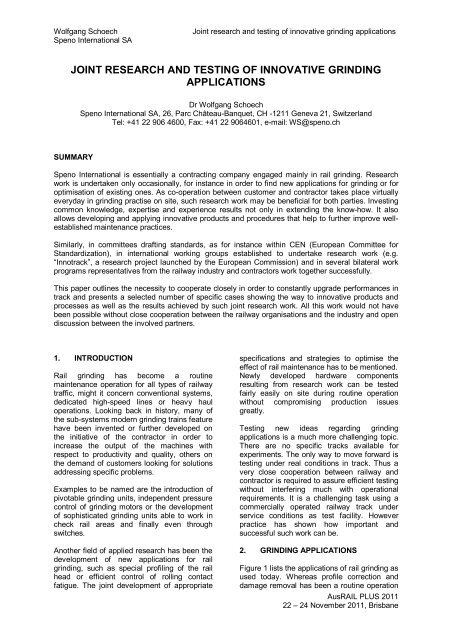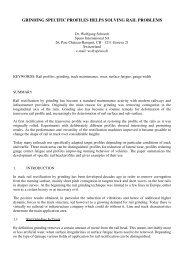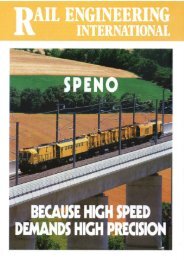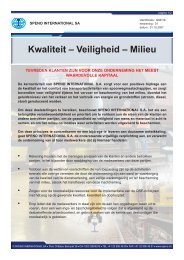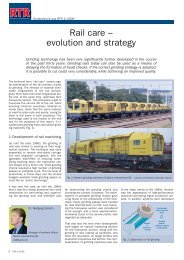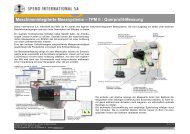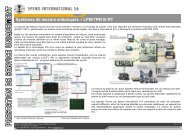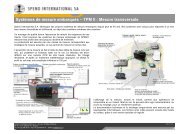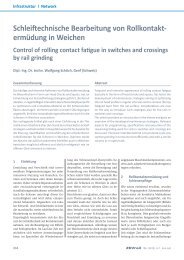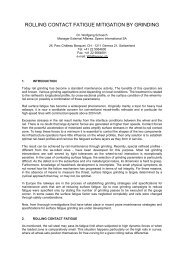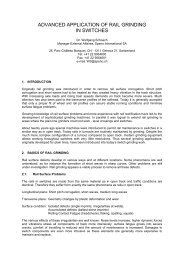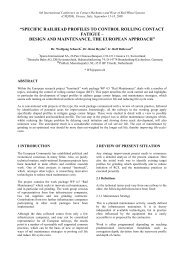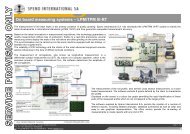joint research and testing of innovative grinding applications - speno ...
joint research and testing of innovative grinding applications - speno ...
joint research and testing of innovative grinding applications - speno ...
You also want an ePaper? Increase the reach of your titles
YUMPU automatically turns print PDFs into web optimized ePapers that Google loves.
Wolfgang Schoech<br />
Speno International SA<br />
Joint <strong>research</strong> <strong>and</strong> <strong>testing</strong> <strong>of</strong> <strong>innovative</strong> <strong>grinding</strong> <strong>applications</strong><br />
JOINT RESEARCH AND TESTING OF INNOVATIVE GRINDING<br />
APPLICATIONS<br />
Dr Wolfgang Schoech<br />
Speno International SA, 26, Parc Château-Banquet, CH -1211 Geneva 21, Switzerl<strong>and</strong><br />
Tel: +41 22 906 4600, Fax: +41 22 9064601, e-mail: WS@<strong>speno</strong>.ch<br />
SUMMARY<br />
Speno International is essentially a contracting company engaged mainly in rail <strong>grinding</strong>. Research<br />
work is undertaken only occasionally, for instance in order to find new <strong>applications</strong> for <strong>grinding</strong> or for<br />
optimisation <strong>of</strong> existing ones. As co-operation between customer <strong>and</strong> contractor takes place virtually<br />
everyday in <strong>grinding</strong> practise on site, such <strong>research</strong> work may be beneficial for both parties. Investing<br />
common knowledge, expertise <strong>and</strong> experience results not only in extending the know-how. It also<br />
allows developing <strong>and</strong> applying <strong>innovative</strong> products <strong>and</strong> procedures that help to further improve wellestablished<br />
maintenance practices.<br />
Similarly, in committees drafting st<strong>and</strong>ards, as for instance within CEN (European Committee for<br />
St<strong>and</strong>ardization), in international working groups established to undertake <strong>research</strong> work (e.g.<br />
“Innotrack”, a <strong>research</strong> project launched by the European Commission) <strong>and</strong> in several bilateral work<br />
programs representatives from the railway industry <strong>and</strong> contractors work together successfully.<br />
This paper outlines the necessity to cooperate closely in order to constantly upgrade performances in<br />
track <strong>and</strong> presents a selected number <strong>of</strong> specific cases showing the way to <strong>innovative</strong> products <strong>and</strong><br />
processes as well as the results achieved by such <strong>joint</strong> <strong>research</strong> work. All this work would not have<br />
been possible without close cooperation between the railway organisations <strong>and</strong> the industry <strong>and</strong> open<br />
discussion between the involved partners.<br />
1. INTRODUCTION<br />
Rail <strong>grinding</strong> has become a routine<br />
maintenance operation for all types <strong>of</strong> railway<br />
traffic, might it concern conventional systems,<br />
dedicated high-speed lines or heavy haul<br />
operations. Looking back in history, many <strong>of</strong><br />
the sub-systems modern <strong>grinding</strong> trains feature<br />
have been invented or further developed on<br />
the initiative <strong>of</strong> the contractor in order to<br />
increase the output <strong>of</strong> the machines with<br />
respect to productivity <strong>and</strong> quality, others on<br />
the dem<strong>and</strong> <strong>of</strong> customers looking for solutions<br />
addressing specific problems.<br />
Examples to be named are the introduction <strong>of</strong><br />
pivotable <strong>grinding</strong> units, independent pressure<br />
control <strong>of</strong> <strong>grinding</strong> motors or the development<br />
<strong>of</strong> sophisticated <strong>grinding</strong> units able to work in<br />
check rail areas <strong>and</strong> finally even through<br />
switches.<br />
Another field <strong>of</strong> applied <strong>research</strong> has been the<br />
development <strong>of</strong> new <strong>applications</strong> for rail<br />
<strong>grinding</strong>, such as special pr<strong>of</strong>iling <strong>of</strong> the rail<br />
head or efficient control <strong>of</strong> rolling contact<br />
fatigue. The <strong>joint</strong> development <strong>of</strong> appropriate<br />
specifications <strong>and</strong> strategies to optimise the<br />
effect <strong>of</strong> rail maintenance has to be mentioned.<br />
Newly developed hardware components<br />
resulting from <strong>research</strong> work can be tested<br />
fairly easily on site during routine operation<br />
without compromising production issues<br />
greatly.<br />
Testing new ideas regarding <strong>grinding</strong><br />
<strong>applications</strong> is a much more challenging topic.<br />
There are no specific tracks available for<br />
experiments. The only way to move forward is<br />
<strong>testing</strong> under real conditions in track. Thus a<br />
very close cooperation between railway <strong>and</strong><br />
contractor is required to assure efficient <strong>testing</strong><br />
without interfering much with operational<br />
requirements. It is a challenging task using a<br />
commercially operated railway track under<br />
service conditions as test facility. However<br />
practice has shown how important <strong>and</strong><br />
successful such work can be.<br />
2. GRINDING APPLICATIONS<br />
Figure 1 lists the <strong>applications</strong> <strong>of</strong> rail <strong>grinding</strong> as<br />
used today. Whereas pr<strong>of</strong>ile correction <strong>and</strong><br />
damage removal has been a routine operation<br />
AusRAIL PLUS 2011<br />
22 – 24 November 2011, Brisbane
Wolfgang Schoech<br />
Speno International SA<br />
New Rail Maintenance Trends In Europe<br />
Anti-Headcheck-Pr<strong>of</strong>iles <strong>and</strong> Preventive Cyclical Grinding<br />
since the introduction <strong>of</strong> rail <strong>grinding</strong>, the use<br />
<strong>of</strong> this technology to improve running<br />
conditions, to reduce lateral wear <strong>and</strong> to<br />
control rolling contact fatigue effectively is the<br />
result <strong>of</strong> fundamental <strong>research</strong> work.<br />
between the wheel <strong>and</strong> the rail. This was<br />
particularly useful as the test set-up allowed<br />
monitoring the effects on vehicles operating<br />
under real traffic conditions.<br />
Particularly the introduction <strong>of</strong> <strong>innovative</strong><br />
special target pr<strong>of</strong>iles for <strong>grinding</strong> work would<br />
not have been possible without <strong>joint</strong> <strong>research</strong>.<br />
Figure 2: Extreme asymmetric pr<strong>of</strong>iles tested<br />
Figure 1: Applications for rail <strong>grinding</strong><br />
3. TARGET PROFILE DEVELOPMENT<br />
Already in the nineteen-eighties <strong>testing</strong> specific<br />
transverse pr<strong>of</strong>iles to better control steering<br />
<strong>and</strong> to reduce lateral wear led to the practice <strong>of</strong><br />
asymmetric rail pr<strong>of</strong>iling. More recently a whole<br />
range <strong>of</strong> new target pr<strong>of</strong>iles for <strong>grinding</strong> has<br />
been developed to improve high-speed<br />
running <strong>and</strong> to reduce the development <strong>of</strong><br />
gauge corner fatigue. Some examples <strong>of</strong><br />
specific <strong>research</strong> projects undertaken in<br />
Europe are discussed in the following section.<br />
Different types <strong>of</strong> vehicles, in particular<br />
locomotives, have been evaluated on a<br />
statistical basis. Important effects, such as the<br />
influence <strong>of</strong> train speed <strong>and</strong> weather<br />
conditions, just to name the most significant<br />
ones, provided interesting insight in the<br />
complexity <strong>of</strong> the wheel-rail interface. The<br />
huge amount <strong>of</strong> data collected made<br />
interpretation <strong>and</strong> evaluation <strong>of</strong> many specific<br />
parameters a challenging work.<br />
Long-term observations <strong>of</strong> the wear<br />
development by circumstantial pr<strong>of</strong>ile<br />
measurements verified the expected reduction<br />
<strong>of</strong> the lateral wear. Today such pr<strong>of</strong>iles have<br />
become a st<strong>and</strong>ard option if lateral wear needs<br />
to be treated.<br />
3.1 Wear Reducing Pr<strong>of</strong>iles<br />
The possibility to improve steering in sharp<br />
curves has been studied in a long term project<br />
starting in 1985 by the Austrian Federal<br />
Railways (ÖBB) <strong>and</strong> Speno International under<br />
supervision <strong>of</strong> the University <strong>of</strong> Innsbruck/<br />
Austria. [1]<br />
In order to explore the possibility to influence<br />
vehicle <strong>and</strong> bogie steering by changing the rail<br />
head geometry extreme pr<strong>of</strong>iles as showing in<br />
figure 2 have been produced in track. In that<br />
era it was a painstaking affair, as a <strong>grinding</strong><br />
machine with fixed <strong>grinding</strong> stone inclinations<br />
had to be used.<br />
Extensive strain gauge measurements in two<br />
test curves (one with st<strong>and</strong>ard pr<strong>of</strong>iles, the<br />
other with specifically designed asymmetric<br />
pr<strong>of</strong>iles) provided data on the immediate effect<br />
<strong>of</strong> asymmetric pr<strong>of</strong>iles on contact conditions<br />
Figure 3: Test site with strain gauge recording<br />
3.2 Gauge Widening Pr<strong>of</strong>iles<br />
A less academic, pragmatic approach has<br />
been taken to attack the problem <strong>of</strong> tight<br />
gauge caused - amongst other reasons - by<br />
shrunken concrete sleepers. This problem<br />
provoked in Denmark <strong>and</strong> in Belgium unstable<br />
running conditions for particular rolling stock. In<br />
Germany it required actions in order to bring<br />
the gauge width back within the legal limits.<br />
AusRAIL PLUS 2011<br />
22 – 24 November 2011, Brisbane
Wolfgang Schoech<br />
Speno International SA<br />
New Rail Maintenance Trends In Europe<br />
Anti-Headcheck-Pr<strong>of</strong>iles <strong>and</strong> Preventive Cyclical Grinding<br />
The question was, whether <strong>grinding</strong> could help<br />
to widen the gauge without changing the basic<br />
contact conditions between wheel <strong>and</strong> rail. The<br />
approach taken <strong>and</strong> the solution found was as<br />
simple as effective: Developing appropriate<br />
<strong>grinding</strong> pattern allowed the nominal target<br />
pr<strong>of</strong>ile for <strong>grinding</strong> (at that time the UIC60<br />
pr<strong>of</strong>ile, now called 60E1) to be shifted relative<br />
to the rail head towards the field side, the<br />
smooth transition being provided by a wide 70<br />
degree facet at the lower end <strong>of</strong> the 13 mm<br />
gauge corner radius.<br />
When starting the first <strong>applications</strong> <strong>of</strong> gauge<br />
widening by <strong>grinding</strong> already more advanced<br />
machines featuring pivotable <strong>grinding</strong> units<br />
were available that helped to set-up respective<br />
<strong>grinding</strong> pattern <strong>and</strong> to achieve remarkably<br />
high production rates. Thus gauge widening by<br />
<strong>grinding</strong> is a very economic undertaking<br />
compared to changing fastenings <strong>and</strong>/or<br />
sleepers.<br />
Any amount <strong>of</strong> gauge widening could thus be<br />
produced. German Railways (DB AG) have<br />
specified a target pr<strong>of</strong>ile, which - if applied on<br />
both rails - opens the gauge by 5 mm. Its<br />
contact area is identical with the st<strong>and</strong>ard<br />
pr<strong>of</strong>ile. The transition is assured by a wide 70-<br />
degree facet at the gauge. [2]<br />
related metal removal rates has been checked<br />
in parallel with pr<strong>of</strong>ile modifications. [3]<br />
Initially five different target pr<strong>of</strong>iles for <strong>grinding</strong>,<br />
within the - at that time - wide production<br />
tolerance b<strong>and</strong>, have been ground precisely on<br />
various test sections. Twenty <strong>grinding</strong> zones,<br />
each 100 meter long <strong>and</strong> containing two<br />
recordings points in their centre have been<br />
selected from the beginning, including<br />
st<strong>and</strong>ard steel <strong>and</strong> heat treated grades. All<br />
these sections have been worked on in<br />
different intervals from one to three years <strong>and</strong><br />
have been inspected <strong>and</strong> monitored three<br />
times per year.<br />
Figure 5: Grinding <strong>and</strong> recording at the test<br />
site near Würzburg/Germany<br />
Figure 6: Example <strong>of</strong> pr<strong>of</strong>ile development<br />
Figure 4: Gauge widening pr<strong>of</strong>ile DB AG<br />
3.3 Anti - Head check Pr<strong>of</strong>iles<br />
Probably the most circumstantial <strong>joint</strong> <strong>research</strong><br />
work ever undertaken in track took place in<br />
Germany, where the appearance <strong>of</strong> rolling<br />
contact fatigue at the gauge, usually referred<br />
to as head checks on conventional lines<br />
became an increasing problem. At first the<br />
effect <strong>of</strong> rail pr<strong>of</strong>iling on the development <strong>of</strong><br />
head checks has been studied.<br />
The originally intended test period <strong>of</strong> some<br />
three to four years has been extended <strong>and</strong><br />
lasted finally 10 years, as after the first project<br />
phase the influence <strong>of</strong> <strong>grinding</strong> cycles <strong>and</strong><br />
Figure 7: Example <strong>of</strong> head checking<br />
In total 1200 transverse pr<strong>of</strong>ile measurements<br />
<strong>and</strong> the same number <strong>of</strong> magnetic particle test<br />
samples have been taken <strong>and</strong> evaluated. Over<br />
5000 photographs document the development<br />
<strong>of</strong> wear <strong>and</strong> fatigue. This detailed monitoring <strong>of</strong><br />
transverse pr<strong>of</strong>iles <strong>and</strong> observation <strong>of</strong> the<br />
AusRAIL PLUS 2011<br />
22 – 24 November 2011, Brisbane
Wolfgang Schoech<br />
Speno International SA<br />
New Rail Maintenance Trends In Europe<br />
Anti-Headcheck-Pr<strong>of</strong>iles <strong>and</strong> Preventive Cyclical Grinding<br />
related head check situation confirmed the<br />
positive effect <strong>of</strong> - however carefully limited -<br />
gauge corner undercutting strikingly. So-called<br />
“Anti-head check-pr<strong>of</strong>iles” are a st<strong>and</strong>ard<br />
recommendation for cyclic rail maintenance<br />
work today.<br />
As described below in chapter 4, this <strong>research</strong><br />
project contributed equally to underst<strong>and</strong> the<br />
influence <strong>of</strong> selected steel grades <strong>and</strong> <strong>grinding</strong><br />
cycles on rolling contact fatigue development<br />
<strong>and</strong> its control.<br />
3.4 Wear Adapted Pr<strong>of</strong>iles<br />
A similar project is on its way in Sweden,<br />
where the infrastructure manager Trafikverket<br />
together with Speno International follows the<br />
result <strong>of</strong> specific pr<strong>of</strong>ile <strong>grinding</strong> at the only<br />
European heavy haul line, called<br />
“Malmbanan”.<br />
Due to the typical traffic conditions wheels<br />
wear to a more hollow shape <strong>and</strong> provoke<br />
therefore rolling contact fatigue on the<br />
st<strong>and</strong>ard target pr<strong>of</strong>iles for <strong>grinding</strong>. As a<br />
consequence specifically adapted new pr<strong>of</strong>iles<br />
have been developed, tested <strong>and</strong> have<br />
become a st<strong>and</strong>ard for rail <strong>grinding</strong>. [4]<br />
Figure 8: Target pr<strong>of</strong>iles at Malmbanan<br />
The results <strong>of</strong> that <strong>joint</strong> project are satisfactory.<br />
But situations may change. Not only has the<br />
axle load increased in the past. As a<br />
consequence the new vehicles have been<br />
fitted with new wheel pr<strong>of</strong>iles <strong>and</strong> maintenance<br />
cycles have changed with their introduction.<br />
Thus, it has been decided to continue the<br />
cooperation regarding the <strong>grinding</strong> strategy<br />
project for some time with a view to identify<br />
requirements or potentials for further pr<strong>of</strong>ile<br />
optimisation.<br />
As a consequence at 6 locations in totally 43<br />
track sections the rails are regularly inspected.<br />
Numerous transverse pr<strong>of</strong>ile recordings - at<br />
each catenary pole in the sections - are made<br />
in order to follow wear caused by <strong>grinding</strong> <strong>and</strong><br />
by traffic.<br />
Additionally Eddy-Current-measurements are<br />
made before <strong>and</strong> after <strong>grinding</strong> in order to<br />
record the situation <strong>of</strong> the head checks. This<br />
will not only allow modifying the target pr<strong>of</strong>iles<br />
if necessary but also enable the infrastructure<br />
manager to optimise metal removal<br />
requirements <strong>and</strong> <strong>grinding</strong> cycles, as described<br />
later in chapter 6.<br />
4. GRINDING STRATEGY<br />
DEVELOPMENT<br />
In this context it is important to mention, that<br />
the above presented <strong>research</strong> programs<br />
address two topics: The first is defining optimal<br />
target pr<strong>of</strong>iles for <strong>grinding</strong>, which assure lowest<br />
contact stresses at the wheel-rail interface; the<br />
second is establishing an appropriate <strong>grinding</strong><br />
strategy, which controls rolling contact fatigue<br />
effectively by simultaneously keeping artificial<br />
wear by <strong>grinding</strong> at a low level.<br />
The main task thereby is to select metal<br />
removal rates <strong>and</strong> to balance them against<br />
head check development <strong>and</strong> natural wear per<br />
<strong>grinding</strong> intervention <strong>and</strong> corresponding<br />
<strong>grinding</strong> intervals. Producing a specific target<br />
pr<strong>of</strong>ile even within tight tolerances has become<br />
a routine operation today. However, metal<br />
removal can only be checked manually at<br />
selected points. Continuous monitoring <strong>of</strong><br />
metal removal in absolute terms on a <strong>grinding</strong><br />
machine is still on the wish list <strong>of</strong> the industry.<br />
Usually the average machine capacity per<br />
<strong>grinding</strong> pass <strong>and</strong> speed is known <strong>and</strong> is taken<br />
as constant, as is the expected growth rate <strong>of</strong><br />
head checks, the rolling contact fatigue<br />
phenomenon with the largest occurrence at<br />
present.<br />
Therefore several <strong>research</strong> projects have been<br />
undertaken so far to study metal removal rates<br />
<strong>and</strong> to specify the number <strong>of</strong> required <strong>grinding</strong><br />
passes <strong>and</strong> working speed as steering <strong>grinding</strong><br />
parameters. The metal removal requirement is<br />
expressed usually in tenth <strong>of</strong> millimetres to be<br />
taken <strong>of</strong>f in the centre <strong>of</strong> the rail head <strong>and</strong> in<br />
intervention cycles (usually expressed in<br />
million gross tonnes).<br />
4.1. Head check treatment –<br />
DB AG/Germany<br />
As outlined above, in Germany already in the<br />
nineteen-nineties surface fatigue, in earlier<br />
AusRAIL PLUS 2011<br />
22 – 24 November 2011, Brisbane
Wolfgang Schoech<br />
Speno International SA<br />
New Rail Maintenance Trends In Europe<br />
Anti-Headcheck-Pr<strong>of</strong>iles <strong>and</strong> Preventive Cyclical Grinding<br />
times only a well known phenomenon for<br />
heavy haul railways, has become a severe<br />
problem for conventional railways using<br />
locomotives deploying high traction forces,<br />
increased axle loads <strong>and</strong> augmented line<br />
speeds. Therefore German railways (DB AG)<br />
<strong>and</strong> Speno International have undertaken<br />
circumstantial <strong>research</strong> work in order to<br />
underst<strong>and</strong> better that phenomenon.<br />
After having studied the influence <strong>of</strong> pr<strong>of</strong>iling<br />
on gauge corner fatigue resulting in production<br />
tolerances featuring gauge corner relief<br />
varying <strong>grinding</strong> cycles have been tested. The<br />
twenty selected test sections for the pr<strong>of</strong>ile<br />
study have been ground to different degrees <strong>of</strong><br />
gauge corner relief, hence different metal<br />
removal requirements, <strong>of</strong> course all within the<br />
specified tolerances <strong>of</strong> the target pr<strong>of</strong>ile for<br />
<strong>grinding</strong>.<br />
The development <strong>of</strong> the pr<strong>of</strong>iles <strong>and</strong> surface<br />
fatigue has been monitored in the same way<br />
as before. It allowed determining the optimal<br />
pr<strong>of</strong>ile shape <strong>and</strong> metal removal requirement<br />
depending fatigue growth. Unfortunately (but<br />
expectedly) the relation between crack growth<br />
<strong>and</strong> <strong>grinding</strong> interval varied according local<br />
parameters. Not surprisingly it has been<br />
decided that shorter cycles within lower metal<br />
removal requirements are in any case<br />
advantageous. The findings <strong>of</strong> this <strong>research</strong><br />
work have later been implemented in a<br />
European wide <strong>research</strong> project, which<br />
described in chapter 6.<br />
4.2 Rail Maintenance Strategy –<br />
Trafikverket/Sweden<br />
The Swedish infrastructure manager<br />
“Banverket” now integrated in “Trafikverket”<br />
has followed the same approach <strong>of</strong> continuous<br />
cooperation as undertaken in Germany, <strong>and</strong><br />
has decided to continue its applied <strong>research</strong><br />
project on target pr<strong>of</strong>iles for <strong>grinding</strong> with a<br />
view to strategically prevent rolling contact<br />
fatigue. [5]<br />
Thus, the earlier selected maintenance<br />
strategy by <strong>grinding</strong> specific pr<strong>of</strong>iles <strong>and</strong> by<br />
removing a specified amount <strong>of</strong> metal from the<br />
rail surface cyclically is closely followed <strong>and</strong><br />
may be adapted at any moment in order to<br />
optimise the chosen rail maintenance strategy.<br />
It has been found that natural wear by traffic is<br />
very low <strong>and</strong> the transverse pr<strong>of</strong>ile does not<br />
change much between <strong>grinding</strong> interventions.<br />
More important is now the issue <strong>of</strong> the metal<br />
removal requirements. In former times just a<br />
minimum requirement was a specified. Today<br />
complete crack removal is the primary goal,<br />
keeping new or correctively ground rails more<br />
or less head check free or at least at an<br />
acceptable low damage level.<br />
More precise metal removal specifications are<br />
now in discussion. Probably an average value<br />
will be specified for the rail centre <strong>and</strong> some<br />
slightly higher value for the field <strong>and</strong> gauge<br />
corner, <strong>of</strong> course maintaining the specifications<br />
for evenness <strong>of</strong> the longitudinal pr<strong>of</strong>ile <strong>and</strong><br />
shape for the transverse pr<strong>of</strong>ile (target <strong>and</strong><br />
tolerance).<br />
The tricky part <strong>of</strong> the exercise is to find a way<br />
to translate the technical idea into a precise<br />
specification, which can be checked by<br />
everyone. That <strong>of</strong> course addresses again the<br />
question <strong>of</strong> how to continuously <strong>and</strong> precisely<br />
measure the work produced by the <strong>grinding</strong><br />
machines.<br />
5. HARD WARE DEVELOPMENT -<br />
RFC - Recording System<br />
Typical examples for <strong>joint</strong> hardware<br />
development were the introduction <strong>of</strong> pivotable<br />
<strong>grinding</strong> motors in the early days <strong>of</strong> rail<br />
<strong>grinding</strong> or later on the incorporation <strong>of</strong><br />
continuously measuring recording systems for<br />
the longitudinal <strong>and</strong> transverse pr<strong>of</strong>ile <strong>of</strong> the<br />
rail head.<br />
In the last decade new recording systems to<br />
detect fatigue cracks have been developed.<br />
Such a system based on Eddy-Current<br />
technology is used by DB AG on a flaw<br />
detection vehicle in order to detect <strong>and</strong> to<br />
classify fatigued gauge corner areas.<br />
It was a logic step to consider the use <strong>of</strong> such<br />
a system on rail <strong>grinding</strong> machines, which<br />
would allow monitoring the reduction -<br />
respectively the elimination - <strong>of</strong> head checks<br />
during <strong>grinding</strong> work. A project team consisting<br />
<strong>of</strong> the manufacturer, the rail <strong>grinding</strong> company<br />
<strong>and</strong> the railway has been set up in order to<br />
combine existing knowledge <strong>and</strong> experience.<br />
First a respective prototype device has been<br />
built, incorporated in a <strong>grinding</strong> machine <strong>and</strong><br />
then tested in track. The results obtained on<br />
the <strong>grinding</strong> sites by the prototype system<br />
have been compared with results coming from<br />
manual devices. Much had to be learned about<br />
rail surface conditions <strong>and</strong> crack geometry with<br />
respect to its influence on the recording<br />
AusRAIL PLUS 2011<br />
22 – 24 November 2011, Brisbane
Wolfgang Schoech<br />
Speno International SA<br />
New Rail Maintenance Trends In Europe<br />
Anti-Headcheck-Pr<strong>of</strong>iles <strong>and</strong> Preventive Cyclical Grinding<br />
system. The system measures the variation <strong>of</strong><br />
an electric field caused by the cracks. Thus,<br />
damage depth, which is the top layer <strong>of</strong> the rail<br />
head surface that needs to be removed,<br />
depends on crack inclination <strong>and</strong> orientation.<br />
[6]<br />
Quite a number <strong>of</strong> modifications on the<br />
recording trolley were required to assure<br />
correct, high precision guiding <strong>of</strong> the probes<br />
closely over the surface, independent <strong>of</strong> the<br />
shape <strong>and</strong> wear situation <strong>of</strong> the rail. Equally<br />
laborious was the development <strong>of</strong> an<br />
appropriate s<strong>of</strong>tware package allowing for<br />
online interpretation <strong>of</strong> the data.<br />
Respective activities are under way in<br />
Australia.<br />
6. DEVELOPMENT OF GRINDING<br />
STANDARDS –<br />
The “INNOTRACK” project<br />
In Europe an international <strong>research</strong> project<br />
funded by the European Commission on<br />
<strong>innovative</strong> maintenance practices for railway<br />
infrastructure (“Innotrack”) has been<br />
terminated recently. Its results are at present<br />
disseminated to help infrastructure managers<br />
in their task <strong>of</strong> economical maintenance <strong>of</strong><br />
heavy duty tracks.<br />
This project also can be seen as a <strong>joint</strong><br />
<strong>research</strong> work between infrastructure<br />
managers <strong>and</strong> contractors. First <strong>of</strong> all regular<br />
meetings <strong>of</strong> the working groups assured an<br />
intense exchange <strong>of</strong> knowledge <strong>and</strong><br />
experience. Some specific test projects have<br />
been undertaken in laboratories by universities<br />
<strong>and</strong> <strong>research</strong> institutions. Other work packages<br />
concentrated on applied <strong>research</strong>.<br />
Figure 9: Eddy-current-system on a rail grinder<br />
Figure 10: Example head check recording<br />
Based on the experiences made a series <strong>of</strong><br />
systems is now in use with selected <strong>grinding</strong><br />
machines. Their continuous use under routine<br />
operational conditions has helped to further<br />
develop <strong>and</strong> fine-tune the system as well as to<br />
explore the limits. Of course, that development<br />
will never have a definite end.<br />
So far quite satisfactory results have been<br />
made. Due to the European railway conditions,<br />
i.e. mixed traffic on conventional lines using<br />
st<strong>and</strong>ard steel grades (R260) it will be<br />
interesting to see the performance <strong>of</strong> this socalled<br />
“HC-Grinding-Scanner” under different<br />
conditions, such as heavy haul operations.<br />
Results <strong>of</strong> such individual tests have been<br />
published <strong>and</strong> discussed earlier on. Due to the<br />
big number <strong>of</strong> project partners (well over thirty)<br />
<strong>and</strong> their previous works <strong>and</strong> experiences, the<br />
project setup allowed to complement, confirm<br />
<strong>and</strong> finetune the various conclusions. As the<br />
project moved on, a big number <strong>of</strong><br />
deliverables, i.e. technical documents has<br />
been published.<br />
Within subproject SP5 the working group WP<br />
4.5 - originally named “Validation <strong>of</strong> new<br />
maintenance processes”, later referred to as<br />
“Rail Maintenance”, looked into the rail sector.<br />
Besides rail lubrication <strong>and</strong> friction<br />
modification, rail repr<strong>of</strong>iling - taking into<br />
account optimal steel grade selection - was the<br />
main topic addressed.<br />
This working group was ordered to produce<br />
four documents:<br />
“Review <strong>of</strong> Present Maintenance Situation”<br />
“Target Pr<strong>of</strong>iles for Grinding”<br />
“Grinding strategies”<br />
“Lubrication <strong>and</strong> Friction Management”<br />
Finally a summary document entitled<br />
“Guidelines for management <strong>of</strong> rail <strong>grinding</strong>”,<br />
containing the most important results has been<br />
produced <strong>and</strong> published. [7]<br />
AusRAIL PLUS 2011<br />
22 – 24 November 2011, Brisbane
Wolfgang Schoech<br />
Speno International SA<br />
New Rail Maintenance Trends In Europe<br />
Anti-Headcheck-Pr<strong>of</strong>iles <strong>and</strong> Preventive Cyclical Grinding<br />
There some <strong>of</strong> the experiences made during<br />
earlier projects described above have been<br />
incorporated <strong>and</strong> are now accessible for all<br />
interested parties. Furthermore UIC regarded<br />
this document that useful, that it has been<br />
transcribed in a so-called “TechRec”, a<br />
Technical Recommendation that – after review<br />
by experts – will be published by UIC <strong>and</strong><br />
UNIFE.<br />
But even there the story does not even stop. At<br />
present a European St<strong>and</strong>ard (prEN13231-5)<br />
is in elaboration describing the basics for rail<br />
maintenance. It is at present in its early<br />
drafting stage; due to the valuable results<br />
obtained in INNOTRACK it is considered to<br />
incorporate the above mentioned guidelines for<br />
management <strong>of</strong> rail <strong>grinding</strong> as an informative<br />
annex.<br />
7. CONCLUDING REMARKS<br />
All the above presented examples <strong>of</strong> <strong>joint</strong><br />
<strong>research</strong> <strong>and</strong> <strong>testing</strong> <strong>of</strong> <strong>innovative</strong> <strong>grinding</strong><br />
<strong>applications</strong> <strong>and</strong> related fields demonstrate<br />
quite clearly that combined efforts provide<br />
multiplied benefits. It is the daily routine<br />
contractual work, which triggers considerations<br />
regarding <strong>research</strong>. It is equally the desire for<br />
innovation which motivates the industry to<br />
reconsider the performance <strong>of</strong> its technologies<br />
<strong>and</strong> used machines.<br />
Only a pragmatic approach by motivated<br />
partners made it possible to achieve<br />
remarkable results. Who would dare to<br />
propose a ten years project? Who would invest<br />
in recording programs without being able to<br />
quantify the economic benefit? In today’s pr<strong>of</strong>it<br />
oriented world basic <strong>research</strong> <strong>and</strong><br />
experimenting with <strong>innovative</strong> ideas just for<br />
curiosity is not rated high priority.<br />
However, following daily work with interest <strong>and</strong><br />
exploring new ways <strong>of</strong> doing has proven<br />
successful. Apparently it is the engineering<br />
approach <strong>and</strong> the method <strong>of</strong> learning by doing<br />
- <strong>of</strong> course in a safe <strong>and</strong> well organised way -<br />
which helped to move forwards <strong>and</strong> which will<br />
hopefully continue to do so.<br />
8. REFERENCES<br />
[1] Schoech W, Kopp E: Asymmetric Railhead<br />
Pr<strong>of</strong>iling, International Railway Journal, August<br />
1989<br />
[2] DB AG: Richtlinie 824_4005A02, 2003<br />
[3] Schoech W, HeyderR, Grohmann HD:<br />
Contact Geometry <strong>and</strong> Surface Fatigue –<br />
Guidelines for Appropriate Rail Maintenance,<br />
Proceedings: 7th International conference on<br />
Contact mechanics <strong>and</strong> Wear <strong>of</strong> rail/wheel<br />
Systems, Brisbane/Australia, 2006<br />
[4] Schoech W, Frick A: Development <strong>of</strong> the<br />
Grinding Practice at Malmbanan, Proceedings:<br />
IHHA Conference Specialist Technical<br />
Session, Kiruna/Sweden, 2007<br />
[5] Schoech W, Frick A, Gustafsson P:<br />
Research towards Perfected Rail Maintenance<br />
at Malmbanan, Proceedings: IHHA Conference<br />
Specialist Technical Session, Calgary/Canada,<br />
2011<br />
[6] Meierh<strong>of</strong>er R, Pohl R: Head Check<br />
Measurement - a Fully-operational System on<br />
a Rail Grinder, Proceedings: World Congress<br />
on Railway Research, Montreal Canada, 2006<br />
[7] Innotrack – Innovative track systems –<br />
Results: D4.5.5 Guidelines for Management <strong>of</strong><br />
Rail Grinding, www.innotrack.eu<br />
AusRAIL PLUS 2011<br />
22 – 24 November 2011, Brisbane


